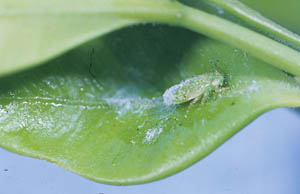Scouting Watch | |
|---|---|
| May 2, 2006 | |
|
The phenology plant of the week is lilac. It is in bloom during the last week of April in central and southern Illinois and will soon be in bloom in northern Illinois. Pine sawfly was reported as having hatched throughout the state in the third week of April. Scout even treated plants because you may see small larvae later in the spring due to delayed hatches. Eastern tent caterpillar has also hatched throughout the state. The young tents at this time of year are only a couple of inches long. Bacillus thuringiensis kurstaki (Dipel, Thuricide), as well as several chemical insecticides, is an effective control. Japanese beetle treatments with soil applications of imidacloprid (Merit) need to be completed by the first few days in May to be effective against the adult beetles later in July. It takes 2 months for the insecticide to travel from the roots throughout the tree. Trunk injections only take 2 weeks, so they can be used later. Elm flea weevil adults should be out in northern Illinois. Look for pinhole damage in the leaves of Siberian and other European elms. An application of carbaryl (Sevin) or a pyrethroid will provide control. Gypsy moth eggs should be hatching in northeastern Illinois. Realize that lightly infested trees are likely to have damage occurring only in the top of the tree. Binoculars are useful for scouting for this early damage. When newly hatched and just starting to feed, the young larvae are black, spiny caterpillars and only about 1/4-inch long. They donít get their characteristic blue and red balls down the back until they approach 3/4-inch long. Boxwood psyllid damage should be visible over the state. The new leaves at the ends of the twigs will be cupped and be turning yellow. The 1/8-inch, green pysllid nymph is on the upper, cupped surface of the leaf. To obtain control, a laminar systemic insecticide such as acephate (Orthene) is needed.  |